In this edition of the Eponaquest News, we celebrate the birthday of a horse who has taught people around the world how to access expanded states of awareness and wellbeing. At the end of this newsletter, you can also read about scholarships and discounts for upcoming workshops, in-person and online. And finally, a special announcement about a brand-new version of the popular Way of the Horse: Equine Archetypes for Self-Discovery book and horse wisdom cards by Linda Kohanov and Kim McElroy, coming soon.
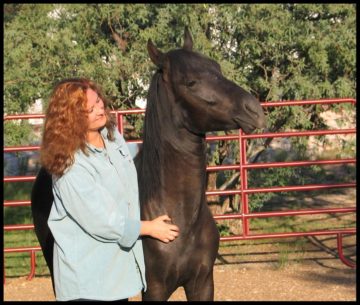
Twin Surprise
By Eponaquest founder Linda Kohanov
March 7, 2022 marks the 20th birthday of Spirit of Epona, a very special horse whose unusual entry into this world brought startling insights into the nature of consciousness, as well as some practical ways to expand our understanding of human potential. On this special occasion, we revisit his story with plenty of photos of his influential early life.

As Spirit showed us so dramatically, myths sometimes hold truths that can enhance our lives in meaningful ways. Cross-cultural legends of the equine ability to take heroes to the Otherworld and back are not just quaint stories, they express a deep understanding of horse consciousness and how living breathing members of the species can help 21st century humans to lead more satisfying, innovative, creative lives.
Through the work of scholars like Carl Jung, Joseph Campbell, and Marion Woodman, ancient myths have been recognized as sources of significant insight still relevant, arguably, essential, to a deeper understanding of life. In her audio program Myths for the Future, Jean Houston defines myth as “something that never was, but is always happening. It’s the coded DNA of the human psyche….Myth waters our every conscious act and is the very sea of our unconscious life.”

The winged horses, centaurs, and mare-headed goddesses of antiquity are archetypes, mythic images that have a certain life and intelligence of their own. Quintessentially, Houston explains, “archetypes are about relationship, and the impetus behind relationship, and the connectedness for the way things grow, evolve, complexify, and ultimately become more integral.” When repressed in the individual or culture, “all kinds of alienation emerges, and one is cut off from nature, self, society, and spirit with consequences seen all over today’s world. This alienation has gained considerably from the mechanistic view of the world, which has touched virtually every level of modern life.”
As nonmaterial patterns of existence, myths and archetypes can hide out indefinitely in the depths of the collective unconscious, but they can’t be suppressed forever. They reappear through the “other great bleed-through realms of human experience: dreams, religious knowings, visions, art, ritual, love, and madness. Sometimes they occur in their archaic forms bearing the accoutrements of earlier cultures, but they ask to be seen in fresh ways. They ask to be regrown.”
Mythic messages actually evolve over time, dressing themselves up in the customs of different eras, drawing attention to destructive patterns of thought and behavior while offering solutions through symbols of transformation. Perpetually looking for an “in” to our world, they search for people who are not just willing to live these patterns unconsciously but actually notice and appreciate them anew. One archetype that has been resurfacing in my work, and most notably in my herd, involves the dual nature of reality. Drawing attention back to an ancient cross-cultural theme, this myth “asked to be regrown” by manifesting physically.
Twins are not common in living horses, yet they play a significant role in horse mythology. From Greece to India to the Celtic lands, stories associated with the divine twins have a strong equine element. In most mythical texts, this is mentioned only in passing. Yet in 2002, the year of the black horse in Chinese astrology, oddly enough, I was gripped by this archetype when my own mare gave birth to twins, despite modern veterinary protocols to prevent it.
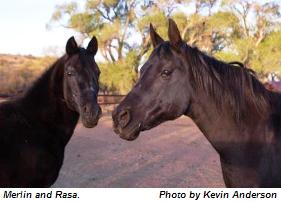
When my mare Rasa and stallion Merlin mated numerous times in 2000 with no result, infertility seemed an issue. Since I wasn’t running a breeding farm, I turned down the option of sperm counts and hormone shots. The following spring, I let the pair cavort together one afternoon, more for their pleasure than any hope of creating a foal. When Rasa showed all the signs of going into heat three weeks later, it seemed unnecessary to order an ultrasound. I had the vet palpate Rasa at four months just to be sure, but once again, there was no sign of a fetus.
Of the 18 percent of equine pregnancies that result in double conception, less than 1 percent of all births involve two foals. Left to their own devices, mares tend to lose both fetuses naturally long before they come to term. Even so, it’s customary in modern veterinary medicine to check for twins. By aborting one, it’s possible to save the other. Since the seemingly infertile Rasa had only mated once that year, the idea that she could conceive at all seemed unlikely. Yet by January, it was obvious the mare was pregnant. Subsequent attempts to see into the womb failed, as “the baby” was positioned beyond the reach of a portable ultrasound. We were all stunned, therefore, when the mare gave birth six weeks early to not one, but two, identical black foals.
The firstborn weighed twenty pounds, one-third the normal birth weight for an Arabian horse. His stillborn brother was significantly larger, but hadn’t been able to survive the cramped space of Rasa’s womb. The vet was doubtful the other foal would live through the night. The first hurdle involved siphoning his mother’s milk into a bottle and hoping he would drink. After a moment of fumbling, he grabbed hold of the nipple and sucked the fluid down like ambrosia. Then he let out a deep, delighted whinny.
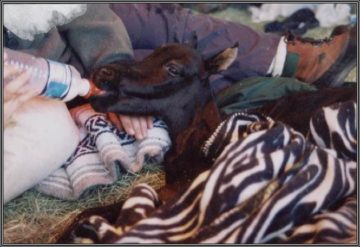
The foal’s enthusiasm seemed to inflate his delicate body. His rich baritone voice, the result of premature vocal chords, seemed so incongruous with his tiny frame that we couldn’t help but laugh out loud when he demanded another bottle. His curious, wide-eyed gaze entranced everyone, including a vet who thought she’d seen everything. The little toy horse looked so pleased with himself, so happy to be in the world, we couldn’t help but rally around him and actually revel in the challenge of keeping him alive.
“Well one thing’s for sure,” I said, “he’s got more spirit than body.” The foal’s name suddenly seemed obvious. “You want some more, Spirit?” I asked as the doctor showed me how to milk Rasa. The little guy responded with an animated rumble.
As the news spread and people came to see Rasa’s tenuous miracle, my husband was left with the most difficult task of all: burying Spirit’s twin, whom we named Sanctus, acknowledging his sacrifice and the effect his brief, sad, profound visit had on us. Later that night, Steve told me of carrying the little foal to his final resting place, of the power and gentleness in those silent eyes, of the insights the twins inspired in him.
“To see life and death side by side,” he said, shaking his head, “to bury one colt and hear the other calling out …”
Steve couldn’t finish the sentence, but I knew he was, like me, swirling between the opposites: not transcending duality exactly, but feeling, really feeling, how joy spills into sadness, how beauty emerges from suffering, and how language can never touch the mystery that informs all life.
Because the bones in Spirit’s knees were not fully formed, we had to put him in a sling when he was awake, and keep him warm when lying down. As the foal continued to grow and thrive, in part through the efforts of people who volunteered during the ten weeks he needed this extra care, I decided to investigate the symbology of twins. I was surprised to find that in cultures around the world, male twins are closely associated with horses. Most often, one brother endures the death of the other, who then connects the survivor to the Otherworld.
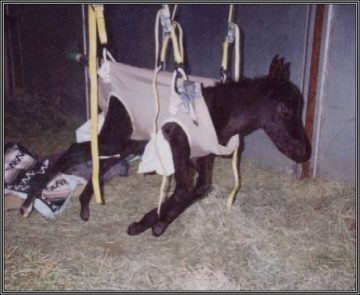
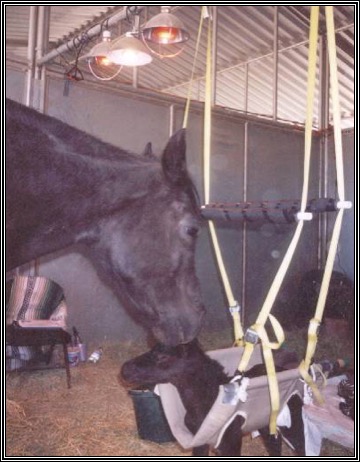
The myth of Castor and Pollux is a prime example. Castor was famous for training horses, Pollux for his skill in boxing. As close as two brothers can be, Pollux was inconsolable after his twin was slain in war and begged Zeus to take his life in exchange. The Greek god instead granted Castor semi-immortality, directing him to spend half his days in the underworld, emerging every other day to visit heaven. Upon Pollux’s death the two were reunited as the constellation Gemini.
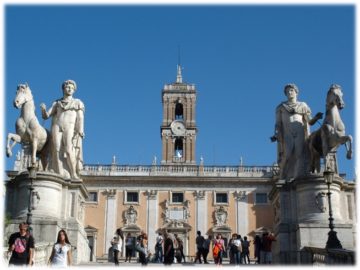
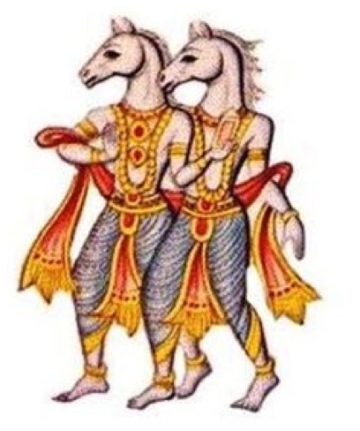
In Thebes, Amphion and Zethus were abandoned at birth and raised by a shepherd. Hailed as great equestrians, they were called the “White Horses,” “The Horsemen,” or “Riders of White Horses,” mirroring the equine associations of Castor and Pollux (who are collectively referred to as the Doscuri, or the “Horseman Gods”). In India, the Asvins were born to the goddess Saranyu. Twins who could take on human or horse form at will, they were also abandoned at birth, yet the brothers went on to create the healing arts.
The Irish goddess Macha gave birth to twins after winning a horse race. The Lithuanian Supreme God had twins through a union with the Great Mother goddess, Lada. These children, significantly, were born in the shape of horses. A number of Eastern twin-myths also share the equestrian associations of their Western counterparts. Many feature a weaker brother, who perishes.
In his book The Soul’s Code: In Search of Character and Calling, the psychologist James Hillman reflects on the mythological theme of sacrificing one of the twins to create balance between this world and the other. The Inuits speak of “another soul,” he writes, “whether internal and in the same body or an external one that comes and goes, alights and leaves, inhabits things and places and animals. Anthropologists who walk with Australian aborigines call this second soul a bush-soul.” Hillman also cites fairy tales, Rumi poems, and Zen stories alluding to “this doubleness, this strange duplicity of life. There are two birds in the tree, a mortal one and an immortal one, side by side. The first chirps and nests and flies about; the other watches.
“The placenta must be carefully disposed of in many cultures, for it is born with you and must not be allowed to enter the life you live. It must remain stillborn and return to the otherworld….Twins themselves are often considered ominous, as if a mistake has occurred; the two birds, the human and the ghost, this world and that, both present in this world. Twins literalize the doppelgänger, visible and invisible both displayed. So tales tell of the murder (sacrifice) of one twin for the sake of the other…The shadow, immortal, otherworldly one gives way so that the mortal one can fully enter this life.”
In an Internet discussion of his paper “Twin Lights of Consciousness, Biology, Microphysics, and Macropsychology,” H. Teich took the symbology of twins to a much deeper level. According to Teich, the “twin nature of light as waves and particles” in quantum theory is reflected in these myths. He theorizes that the overwhelming tendency to depict the twins as two males, rather than as male and female, is an expression of the genetic chromosomal code. “Since females are already twinned at the chromosome level (XX), perhaps the symbolic archetypal image of twin males…is a mythological compensation for biology.”
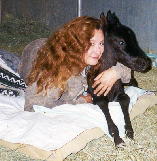
As I raised an equine twin, it took me months of research and reflection to integrate these concepts. Basically, the entire experience gave me yet another reason to believe in a vast coordinating intelligence that speaks to people through dreams, art, and visions – and occasionally, through the physical manifestation of archetypal themes. Through Spirit and his stillborn brother, Sanctus, the twin nature of consciousness engaged our attention in the most vivid way possible. We saw, for one brief moment, the two lying side by side. In naming the stillborn twin, in touching him – and in being touched emotionally by his brief, sad life – we forged a stronger bond with the numinous, archetypal realm of origins.
In quantum theory, the most basic building blocks of life have a dual nature, appearing as particles with a set location in time and space, and as waves, invisible regions of influence that can flow through walls, resonate with physical matter, and yet not be limited by the laws that hold physical beings together. Through this strange, unusually public horse-birth, the universe was upping the ante on a cross-cultural theme. If women already contain “the twins” genetically (as XX chromosomes), it alludes to why feminine wisdom is associated with intuition – ways of knowing not limited to physical and logical laws. The two male twins seemed to be an attempt to bridge the gap between the worlds in masculine consciousness. They manifested this time not as horsemen but as actual horses: nonpredatory beings who, though domesticated, retain a vital connection to instinct and nature while also being associated mythically with a strong sixth sense and the ability to carry riders between this world and the other. The fact that the stronger, larger twin was sacrificed emphasized, for me, the need for a stronger connection to the Otherworld at a time when logic has become much more dominant than it was during the era of Greek myths.
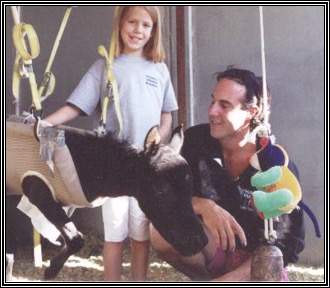
Nearly one hundred volunteers, clients, and Epona staff were drawn into horse consciousness through the act of caring for a foal as one of their own. This never would have happened had Spirit been able to stand and nurse at birth. In this sense, Spirit also bridged the gap between horse and human, drawing nourishment and love from both species. In the wild, he never would have survived.
Yet perhaps even more interestingly, people who came to help Spirit felt a palpable sense of numinosity in the room. They left deeply moved, sometimes having life-changing responses to the unmistakable presence of a huge, open-hearted being in a tiny, fragile body. Spirit’s ability to inspire others during his time of greatest physical weakness also underlined the paradoxical power of vulnerability at a time when technology insulates us from the elements and allows us to destroy our enemies with remarkable ease and efficiency.
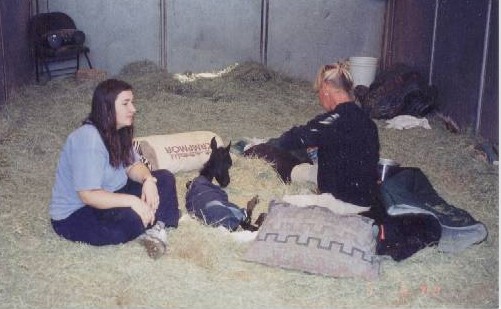
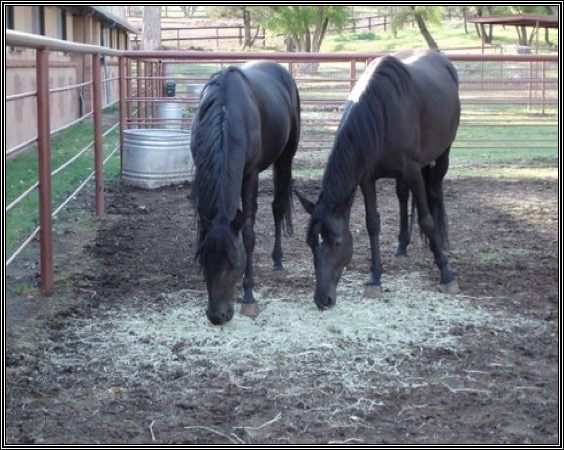
Over the years, Spirit continued to grow and thrive. His mate, a mustang named Panther, was also born in 2002. Panther has a unique healing gift that Spirit’s mother Rasa also exhibited. Her motherly presence is nourishing to vulnerable people and also fiercely protective of humans and herd members who need support.
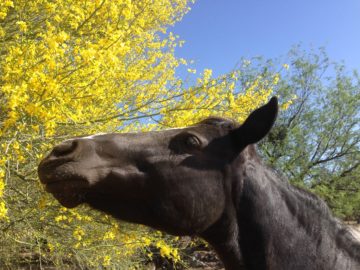
In 2007, Spirit and Panther gave birth to their daughter Artemis, a spirited mare who still lives with her parents and uncles. (Spirit was gelded soon after Artemis was born so that he could enjoy life with his own herd.) She is the third generation of horses who were not weaned suddenly and ripped away from loved ones. As a result, she is very secure and assertive. She teaches people how to be strong, compassionate, and trustworthy.
And Spirit? His life continues to express the twin nature of consciousness in synchronous ways. While there is no way to prove if he is still in contact with his brother, an imprint of the twin somehow solidified in Spirit’s body. When artist Kim McElroy took photos of Spirit to create a painting of the twins for the Way of the Horse deck, we were surprised to find that the camera had picked up the image of an identical black horse’s face emblazoned on Spirit’s shoulder. Sometimes, when the light shines just right, we can still see this otherworldly twin, growing right alongside his brother, reminding us that our own bodies are vehicles for two forms of consciousness, one that runs and rears through this world, and one that flies free in the other.
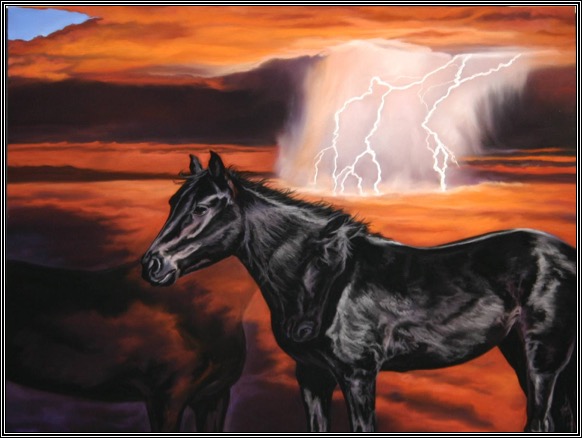
Throughout the last 20 years, Spirit’s story inspired humans to access the dual nature of consciousness, encouraging people from all walks of life to exercise their own “otherworldly twin” while also cultivating a realistic, grounded, logical mindset. Bringing these twins into balance has many benefits. Embracing the mythic dimension of life is like meeting a wiser, more adventurous twin. Our psyches have a supernatural element fond of improvising on timeless themes, and it can help us make sense of seemingly unexpected or challenging events.
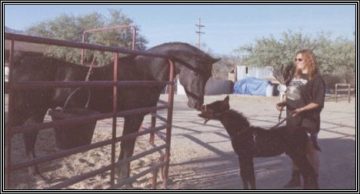
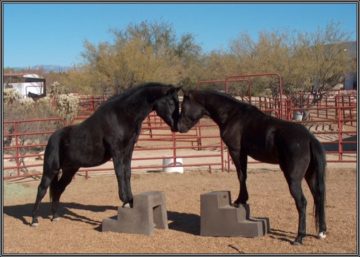
Consciousness separated from its spiritual roots interprets daily existence as an empty progression of chance encounters and meaningless suffering. Learning to move fluidly between multiple states of being is difficult for the modern mind. Through his unusual birth, Spirit brought to light a way that humans with a variety of beliefs can develop a stronger connection to, and between, two forms of consciousness: a soaring consciousness that defies logic to access creativity and intuition, and a grounded consciousness that relies on logic to negotiate earthly challenges. Workshops like Black Horse Wisdom and Harnessing the Invisible grew out of this equine-inspired wisdom, and they continue to be among Eponaquest’s most popular seminars.
Scholarships and Discounts for Upcoming Programs
We are pleased to announce that 3 partial scholarships are available for each of our upcoming spring programs including Beyond Words: The Art and Science of Sentient Communication (April 29 through May 2) https://eponaquest.com/workshop/beyond-words-the-art-and-science-of-sentient-communication-2/, and Black Horse Wisdom (May 14 through 17) https://eponaquest.com/workshop/black-horse-wisdom-3/. See the links for in-depth workshop descriptions.
Nelda University, which produces Linda’s online course Connections 101: Life Wisdom from the Herd, has offered financial support to fund a break in tuition for people who would like to attend one of these upcoming workshops, representing $600 off the standard cost. These partial scholarships are available on a first-come, first-serve basis. Contact Sue Smades at info@eponaquest.com to access one of these scholarships.
For One Week Only: 40 Percent Off Linda’s Online Course
And in honor of Spirit’s 20th birthday, those who are interested in Linda’s online course can register at a discount of 40 percent off. Just go to https://nelda.tv/connections-with-linda-kohanov/ to see a quick overview of this 7-hour, multi-media course. Then, when you enroll, simply enter the coupon code “Spirit” to get 40 percent off. The discount is available for exactly one week from his March 7th birthday, expiring on March 14th. Special thanks to Nelda Sue Yaw and the entire Nelda University staff for making these events and scholarships possible.
A New Edition of Way of the Horse
Spirit’s story was adapted for this newsletter from an essay Linda originally wrote for Way of Horse: Equine Archetypes for Self-Discovery. This popular book and horse wisdom card deck with illustrations by Kim McElroy, has been out of print for the last year. We are pleased to announce that a new publisher has commissioned a revised version of this project with updated text—and two new cards with accompanying essays. “I’m so excited that St. Martin’s Press has stepped forward to publish this new version, which will be available later this summer,” Linda says. “It was fun to bring in some research that wasn’t available when Kim and I originally conceived this project back in 2007. And it was important to be able to update information on the horses whose stories were featured in the book.”
For additional questions, please contact the Eponaquest office at 520-455-5908 or info@eponaquest.com.